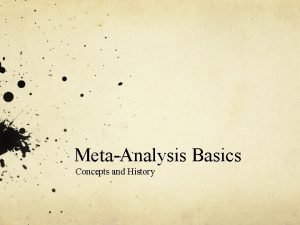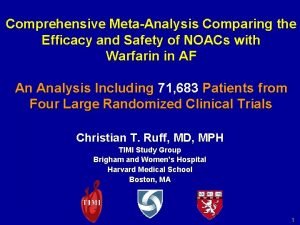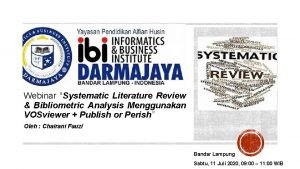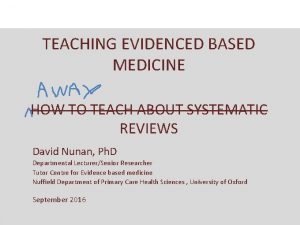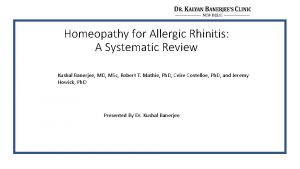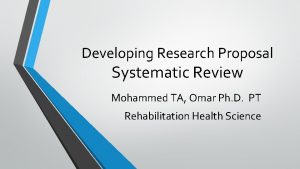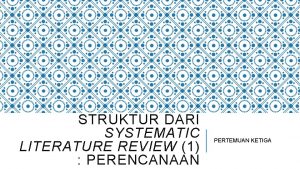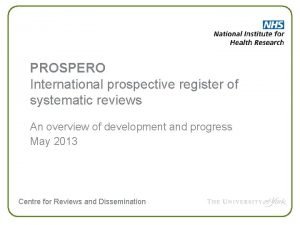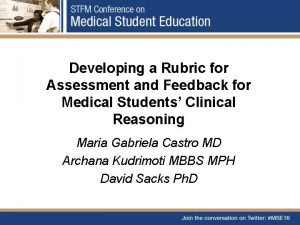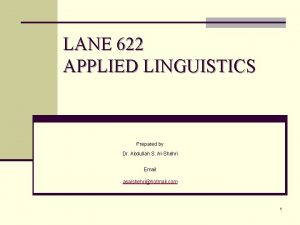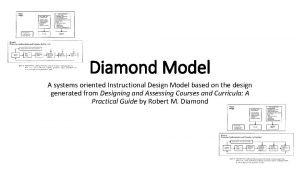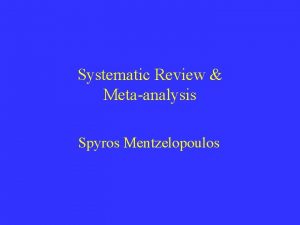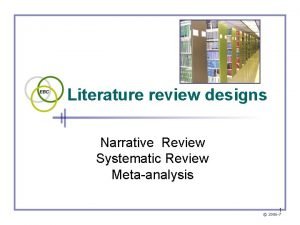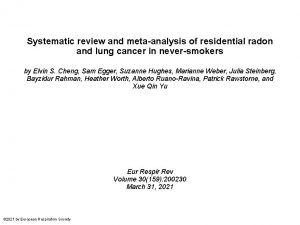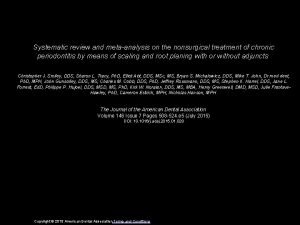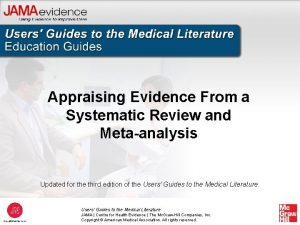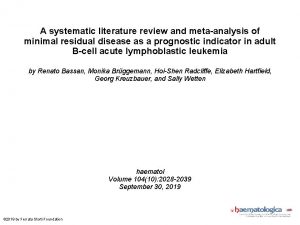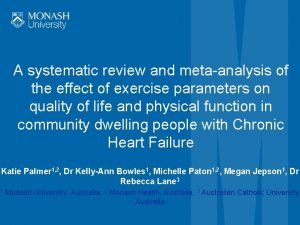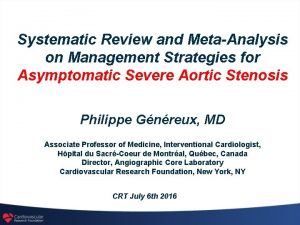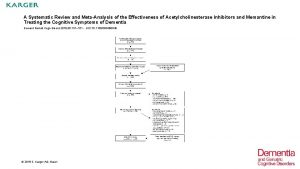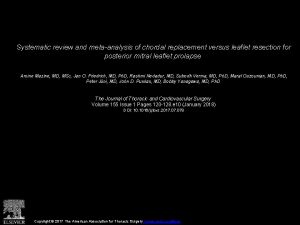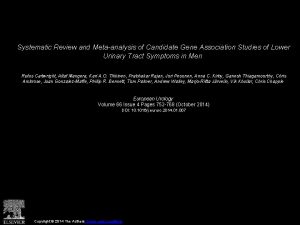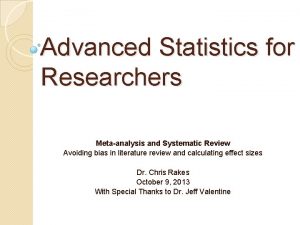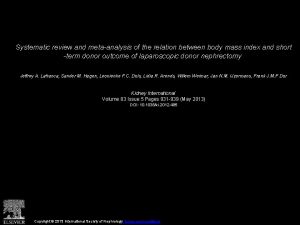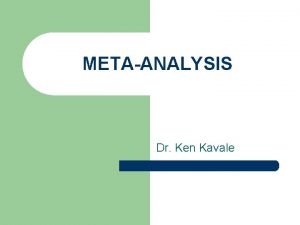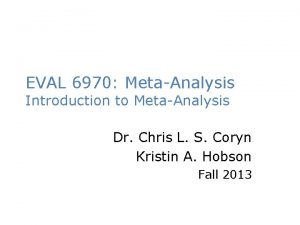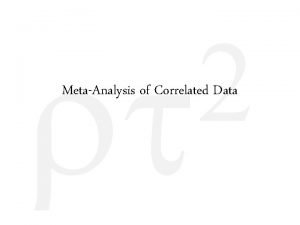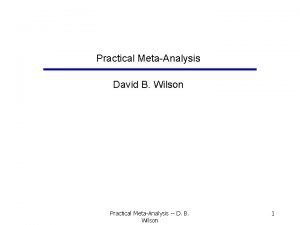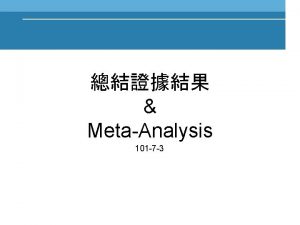Systematic Review and Metaanalysis 2018 09 13 R




























- Slides: 28

Systematic Review and Metaanalysis 2018. 09. 13. R 3 이철형 / Pf. 이정훈


Introduction l EASL and previous guidelines from AASLD recommend the BCLC staging system for treatment allocation and predicting prognosis l For intermediate and advanced stage HCC patients, primary hepatectomy(PH) is not the optimal treatment option.


Introduction l East-Asian countries recommend PH for a broader spectrum of HCC patients - APASL, AHBPA, KLCSG, JSH - According to databases, majority of non-ideal candidates underwent PH in numerous tertiary surgical centers and reported remarkable survival outcomes l Yin et al. (2014) compared PH to TACE alone for patients exceeding Milan criteria, and found PH to be superior after 3 -year follow up (HR 0. 43; p<0. 001)

Introduction l Potential advantage of PH for BCLC stage B/C patients is growing. l Purpose of study – Determine comparative survival benefits of PH and TACE for treatment of BCLC B/C HCC patients via Systematic review and meta-analysis of RCT and high -quality nonrandomized studies

Materials & Methods l Search strategy – Comprehensive, systematic search was done using Pub. Med, EMBASE, Cochrane Library databases ( Sep 22, 2017) – Keywords: “hepatocellular carcinoma, ” “HCC, ” “intermediate, ” “advanced, ” “BCLB B, ” “BCLC C, ” “hepatectomy, ” “hepatic resection”

Materials & Methods l Study selection – Inclusion criteria • Comparing PH to TACE as initial Tx modalities in BCLC-B/C HCC patients • Including at least one evaluation for OS outcome • >=18 years, published after 2000 • The most recent or informative publication data was chosen if multiple publications from the same population exist – Exclusion criteria • Non-HCC or recurrent HCC • Non-comparative studies • Reporting PH with preoperative or postoperative TACE • With no BCLC classification or survival data

Materials & Methods l Quality assessment of studies – Cochrane risk of bias was used to assess RCT – For NRCTs, modified Methodological Index for Nonrandomized Studies (MINORS) score was used • Having MINORS score >=12 have been selected

Materials & Methods l Primary time-to-event outcomes – OS and 1 -, 3 -, 5 -year survival rates – HRs and 95% CI for OS extracted by multivariate Cox proportional hazard models * Procedure related mortality: in-hospital mortality or 30 -day mortality after each treatment

Materials & Methods l Statistical analysis – OS (in terms of log HR, and 95% CI) was analyzed using an inverse variance model – 1 -, 3 -, 5 -year survival rates and procedure related mortalities were pooled in terms of OR and 95% CI by Dersimonian-Laird method – Between-study heterogeneity was calculated using Higgins’ I 2 statistics

Materials & Methods (Cont’d) – Pooled HRs, ORs were initially calculated for RCT and propensity score matched (PSM) NRCTs => all NRCTs were included in the meta-analysis – Subgroup analyses • BCLC stage, proportion of baseline CTP A population – Sensitivity analyses performed to reduce interstudy heterogeneity • Patient factors, tumor factors, HBV dominance, tumor #, tumor thrombosis, publication after 2015, Asians


Results l Study demographics and quality of evidence – Eighteen trials (one RCT, five PSM NRCTs, and 12 NRCTs) consisting of 20 data sets and total 5, 986 patients were included in meta-analysis – Nine studies with 3, 457 patients included BCLC stage B patients, another nine trials with 3, 051 patients enrolled BCLC stage C patients – Most studies enrolled the Asian population except for one. – Majority of enrolled patients were CTP class A ranging from 60 to 100% – Five studies showed mainly ≤ 3 numbers of tumor (≥ 80% patients) – Risk of bias for an RCT was low, all eligible NRCTs (MINOR score >=12)

Results l Primary outcomes: Overall survival



Results l Primary outcomes: 1 -, 3 -, 5 -year survival



Results

Results

Results l Meta-regression analysis

Results l Procedure related mortality

Discussion l In the past, primary surgical resection was not preferred treatment owing to increased surgical complications, liver decompensation and tumor recurrence rate l Present systematic review and meta-analysis PH showed 40% decrease in OS rate and greater than 2. 5 - fold increase in 5 -year survival rate than TACE for intermediate to advanced HCC patients l The survival benefits persisted across subgroups, sensitivity, and metaregression analyses, with significant heterogeneity

Discussion l Results of the study should be interpreted with caution – High proportion of Child A patients – Current international guidelines for BCLC stage C HCC patients is systemic therapy with molecular targeting agents. l Limitations of study – Most evidence are based on NRCTs, only one RCT was available – Substantial degree of heterogeneity, albeit sensitivity/meta-regression analyses. – Most of the populations are Asians, comprising HBV endemic area HBV-associated HCC tends to have well-preserved liver function

Conclusion l As mentioned earlier, the study largely includes Child A and HBVassociated HCC patients, which may contributes overestimating effect of surgical measure l Although procedure related mortality did not differ significantly, there is trend toward increasing mortality for PH. If individual data analysis were available, furthur investigation would be needed l Development of chemotherapy, intervention (DC bead, TARE) is also rapidly developing. Multimodality treatment plan should be considered l Need to elucidate indications of PH – Age, subgrouping of Child B, comorbidities

 What is metaanalysis
What is metaanalysis Comprehensive metaanalysis
Comprehensive metaanalysis Nader amin-salehi
Nader amin-salehi Example of inclusion and exclusion criteria
Example of inclusion and exclusion criteria Narrative review vs systematic review
Narrative review vs systematic review Vosviewer alternative
Vosviewer alternative Que letra continua m v t m j
Que letra continua m v t m j Qfas systematic review
Qfas systematic review Homeopathy for allergic rhinitis: a systematic review
Homeopathy for allergic rhinitis: a systematic review Prospero review registration
Prospero review registration Research proposal systematic review
Research proposal systematic review Statistik inferensial menurut para ahli
Statistik inferensial menurut para ahli Systematic review in history taking
Systematic review in history taking Pengertian systematic review
Pengertian systematic review International prospective register of systematic reviews
International prospective register of systematic reviews Systematic review in history taking
Systematic review in history taking Biology semester 1 review 2018
Biology semester 1 review 2018 Chapter review motion part a vocabulary review answer key
Chapter review motion part a vocabulary review answer key Writ of certiorari ap gov example
Writ of certiorari ap gov example Life span theories
Life span theories Systematic sampling advantages and disadvantages
Systematic sampling advantages and disadvantages Political science importance
Political science importance Systematic and random error
Systematic and random error Deliberate and systematic manner
Deliberate and systematic manner How to avoid parallax error
How to avoid parallax error Aptitude intelligence and systematic forgetting
Aptitude intelligence and systematic forgetting Diamond model of curriculum development
Diamond model of curriculum development Systematic innovation examples
Systematic innovation examples It is a poetic foot that has a pattern of weak syllable
It is a poetic foot that has a pattern of weak syllable
